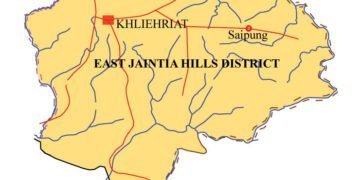The usual practice in every society is that men always venture outside their domestic sphere and women always confine themselves to domestic affairs. The natural practice in any family of every culture is always choosing men to be the head of the family. Males are always perceived as the protectors of female members in the family or the community. Therefore, men are always chosen representatives and leaders of the community. So is the case with Khasi society; for every rule, there are exceptions. The same prevails everywhere and is enshrined in the Khasi customs. If there are cases where no male member of a particular family is capable of representing the family, a matured and intelligent woman of that family is bound to be chosen to represent and may become a leader in the community. There are instances of such nature that have taken place in the past. Even if it is an oral narrative, it reflects the outlook of the community. Most people, perhaps the Khasi people in particular, are acquainted with the story of Ka Pahsyntiew, Ka Syiem Latympang, Ka Ïang, Ka Khmah and others. Ka Pahsyntiew was instrumental in the reconciliation process of the dilemma that prevailed in the Raij Sawkher Lailyngdoh by virtue of her balance of judgment and fairness. Thus she was anointed to become the original ancestress of the royal clan of Shyllong State or Hima Shyllong; the royal clan lineage that descended into the present Syiem of the Hima Khyrim and Hima Mylliem. In the similar manner when there were crisis in other parts of the land, there were situations that women arose as undisputed leader to salvage the plight of ki khun ki hajar or the citizens; like in the case of Syiem Latympang in the Pnar region, Ka Ïang in the Bhoi region, Ka Khmah in the highland region of Mawphlang and so on and so forth.
In recent history, even Ka Phan Nonglait from the West Khasi Hills region had a vital role in dealing with the crisis in the community during the resistance movement against the British imperialist. In the subsequent period of post-colonialism, Mavis Dunn Lyngdoh became a prominent political leader by virtue of her personal merit, not by any special allocation. Even at the present juncture, Roshan Warjri, M Ampareen Lyngdoh, and a few others have emerged as prominent leaders of their own worth and personal aptitude. Further, in other aspects of society, Kong Helimon Diengdoh, Silverine Swer, Sitimon Sawian, Rosemilian Bathew, Patricia Mukhim, Dr Helen Giri and many others have had their share of leadership ability in society with their personal acumen in their respective field, which have contributed to the growth of society. There were no quotas for them and they have excelled more than several other men and women.
It is strange to note that outside the boundary of Meghalaya State, the Khasi people abided with the tradition that is relevant and effective in their respective areas. The tradition prevailed in the Khasi dominion of Bangladesh and in certain parts of North Cachar Hills and Barak Valley of Assam. At a certain point in time, there are villages where women are elected as the chief authority or Rangbahshnong in a few villages in Barak Valley. This situation indicated that they may not be well versed with the social situation in Meghalaya and may lack formal education, but they knew the roots and were fully acquainted with their tradition that was not contaminated with colonial interference. However, the so-called educated elite of Meghalaya seem or pretend to know a lot of customary laws insufficiently or without rationale following the wrongly interpreted version of the British colonial rulers. The irony is that it is still prevailing and incorporated in the formal legal procedure, either by the book or by convention at the cost of the genuine customary laws inherited from the ancestors.
The label of the term rangbah is strictly for men and the mustache or tmaiñ issue in the Khasi dorbar is the result of British misinterpretation that the present generation in Meghalaya follows blindly. Nevertheless, the British have documented the customary laws, lest certain aspects might have vanished or become redundant.
Therefore, the customs and practices are already in place that women with matured age and sound minds are eligible to represent and become leaders in the Dorbar at every level. In fact, the tradition provided a privileged option for women with substance, although not for every woman whether young or elderly.
The preference for men in the leadership domain became a rule in all societies throughout the world. Whether in a cult or secular context throughout the ages, men have always dominated the affairs of the state, and women are confined to domestic matters. The religious scriptures revealed that Jesus, as a man, chose men only as his able disciples and the same is with Shiva, Rama, and other divine entities of various religions. The myths, legends, and history also testimonised the legacy of masculine royal supremacy, even as feminine leadership was more than often the last resort of survival for any community. In every sphere of activities, men always dominate; the army, trade, governance, and all such professions are masculine in nature. While aesthetics, beauty care, health care, and hospitality are the domain of the feminine. However, in the modern world, gender is irrelevant and attitude, merit, and performance is. Everybody knew about Golda Meir of Israel, Margareth Thatcher of England, Indira Gandhi in our Indian union, Aung San Suu Kyi of Myanmar, and many other women leaders throughout the world.
Genetically, man is usually the provider of resources and woman is the bearer and custodian of resources. Usually, all the seeds nurtured by a woman are sown by a man in the field, and all the crops cultivated by a man are reaped and kept in the care and custody of the woman. All the procreation work is provided by a man and bear by a woman for care and custody. Man, the father could never provide maternal care and affection as much as the mother; whereas a mother may be compelled to provide both mental and material requirements and nourishment to her children when the situation demands. Further, a mother or a woman could be able to head or lead the family, the clan, the community, and even the state. However, there are hardly any instances in which man will acquire the knack for maternal care and always emerge as the head of a family, clan, community, and so on and so forth.
In Khasi custom, it is prohibited to inherit the title or surname of a woman or man. The Khasi people consider the lineage through the womb of the mother, the natural link of the umbilical cord from the mother to her infant. Therefore, the maternal clan surname is considered to be every descendant by birth, which indicates that the mother’s umbilical cord is connected with that of the infant she conceived.
It is only the mother that can conceive and give birth to an infant whose umbilical cord is connected to her womb. This link is natural and considered divine. Every infant human being has to be separated from the mother and provide freedom of life for the newborn child. This is also mandatory and divine. It is the natural process of procreation. According to Khasi’s thought, all mothers are female and all females may not be mothers. a mother should be able to conceive and give birth, and barren men and women are not given the decree for procreation by the law of nature that is perceived as the Almighty Creator; however, they are eligible to participate and lead the community if nominated at a different level of the Dorbar.
In the Khasi custom, the foster parents also could not bestow their surname to the adopted child that is not of the mother’s clan. Therefore, adoption in Khasi culture is mandatory for any mother or sterile married woman to espouse a child from the maternal clan. It is usually preferable to adopt the child of a sister with proper consent, particularly if the family suffers from insufficient means of sustenance.
The Khasi philosophy on the genesis of mankind is based on the legend of U Lum Sohpetbneng. Humankind, comprising seven huts or seven families, descended from heaven through the Golden Bridge atop the Sohpetbneng peak to settle on earth by a divine decree. This is the foundation of the procreation of the human race on earth. The clan lineage is traced from the mother’s umbilical cord inside the womb. Hynñiewtrep Hynñiewwasa is the world view of Khasi philosophy, which refers to the entire human race, to the whole of mankind. The father is the provider of the seed and the mother takes ten lunar months to conceive, nourish, and animate the infant into a refined and full-grown human until it is matured and ready to give birth and live on earth. This is the elaborate process that determines the ancestry, even after death, all the bones of all the clan members are to be deposited in the maternal ossuary.

























